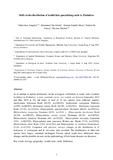Please use this identifier to cite or link to this item:
https://cris.library.msu.ac.zw//handle/11408/3025Full metadata record
| DC Field | Value | Language |
|---|---|---|
| dc.contributor.author | Sungirai, Marvelous | |
| dc.contributor.author | Abatih, Emmanuel Nji | |
| dc.contributor.author | Moyo, Doreen Zandile | |
| dc.contributor.author | De Clercq, Patrick | |
| dc.contributor.author | Madder, Maxime | |
| dc.date.accessioned | 2018-05-07T10:10:37Z | |
| dc.date.available | 2018-05-07T10:10:37Z | |
| dc.date.issued | 2017 | |
| dc.identifier.issn | 0269-283X | |
| dc.identifier.uri | https://onlinelibrary.wiley.com/doi/abs/10.1111/mve.12215 | |
| dc.identifier.uri | http://hdl.handle.net/11408/3025 | |
| dc.description.abstract | Ixodidae) in Zimbabwe, a cross‐sectional survey was carried out between September 2013 and May 2015 at 322 dip tanks. A total of 15 tick species were collected, namely: Amblyomma hebraeum Koch (65.2%, n = 210/322), Amblyomma variegatum Fabricius (14.9%, n = 48/322), Hyalomma rufipes Koch (62.4%, n = 201/322), Hyalomma truncatum Koch (37.9%, n = 122/322), Rhipicephalus appendiculatus Neumann (60.6%, n = 195/322), Rhipicephalus compositus Neumann (0.3%, n = 1/322,), Rhipicephalus decoloratus Koch (61.8%, n = 199/322), Rhipicephalus evertsi evertsi Neumann (65.2%, n = 210/322), Rhipicephalus lunulatus Neumann (4%, n = 13/322), Rhipicephalus microplus Canestrini (32%, n = 103/322), Rhipicephalus near punctatus Walker and Horak (7.1%, n = 23/322), Rhipicephalus simus Koch (5.6%, n = 18/322) and Rhipicephalus cf. turanicus Pomerantsev (3.4%, n = 11/322). Compared with previous surveys, changes in the distribution of A. hebraeum, A. variegatum and R. microplus were recorded. The distributions of other tick species have largely remained unchanged. Factors which might have influenced these changes and the possible impacts on the epidemiology of tick‐borne diseases are discussed. | en_US |
| dc.language.iso | en | en_US |
| dc.publisher | Wiley (The Royal Entomological Society) | en_US |
| dc.relation.ispartofseries | Medical and Veterinary Entomology;Vol. 31; p. 78–87 | |
| dc.subject | Cattle | en_US |
| dc.subject | Ecology | en_US |
| dc.subject | Geography | en_US |
| dc.subject | Ixodid | en_US |
| dc.subject | Ticks | en_US |
| dc.subject | Zimbabwe. | en_US |
| dc.title | Shifts in the distribution of ixodid ticks parasitising cattle in Zimbabwe | en_US |
| dc.type | Article | en_US |
| dc.type | Pre-print | |
| item.openairecristype | http://purl.org/coar/resource_type/c_18cf | - |
| item.openairecristype | http://purl.org/coar/resource_type/c_18cf | - |
| item.grantfulltext | open | - |
| item.cerifentitytype | Publications | - |
| item.cerifentitytype | Publications | - |
| item.languageiso639-1 | en | - |
| item.fulltext | With Fulltext | - |
| item.openairetype | Article | - |
| item.openairetype | Pre-print | - |
| Appears in Collections: | Research Papers | |
Files in This Item:
| File | Description | Size | Format | |
|---|---|---|---|---|
| Sungirai_Shifts_2017.pdf | Full Text-pre-print | 985.45 kB | Adobe PDF |  View/Open |
Page view(s)
32
checked on Jul 25, 2024
Download(s)
8
checked on Jul 25, 2024
Google ScholarTM
Check
Items in MSUIR are protected by copyright, with all rights reserved, unless otherwise indicated.



